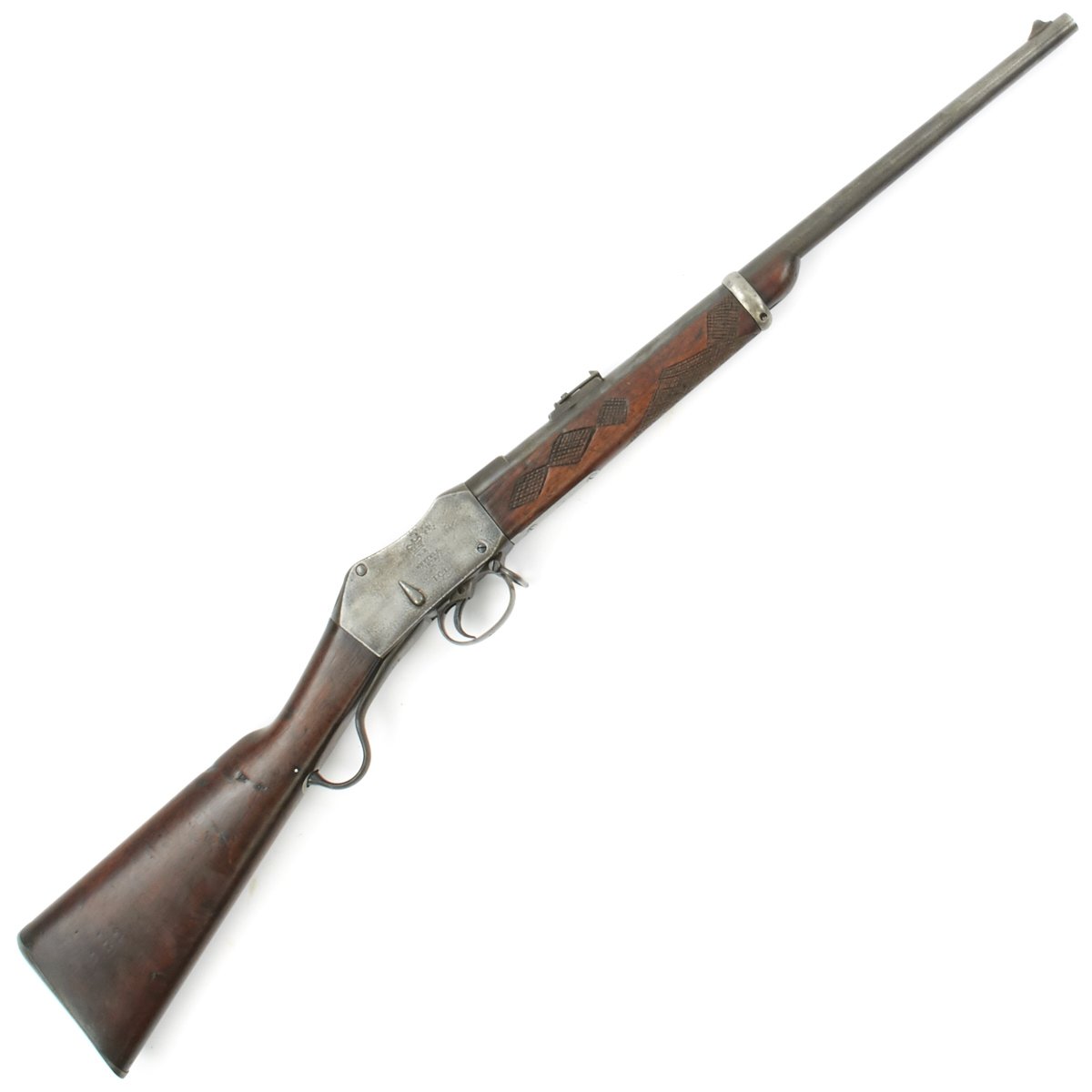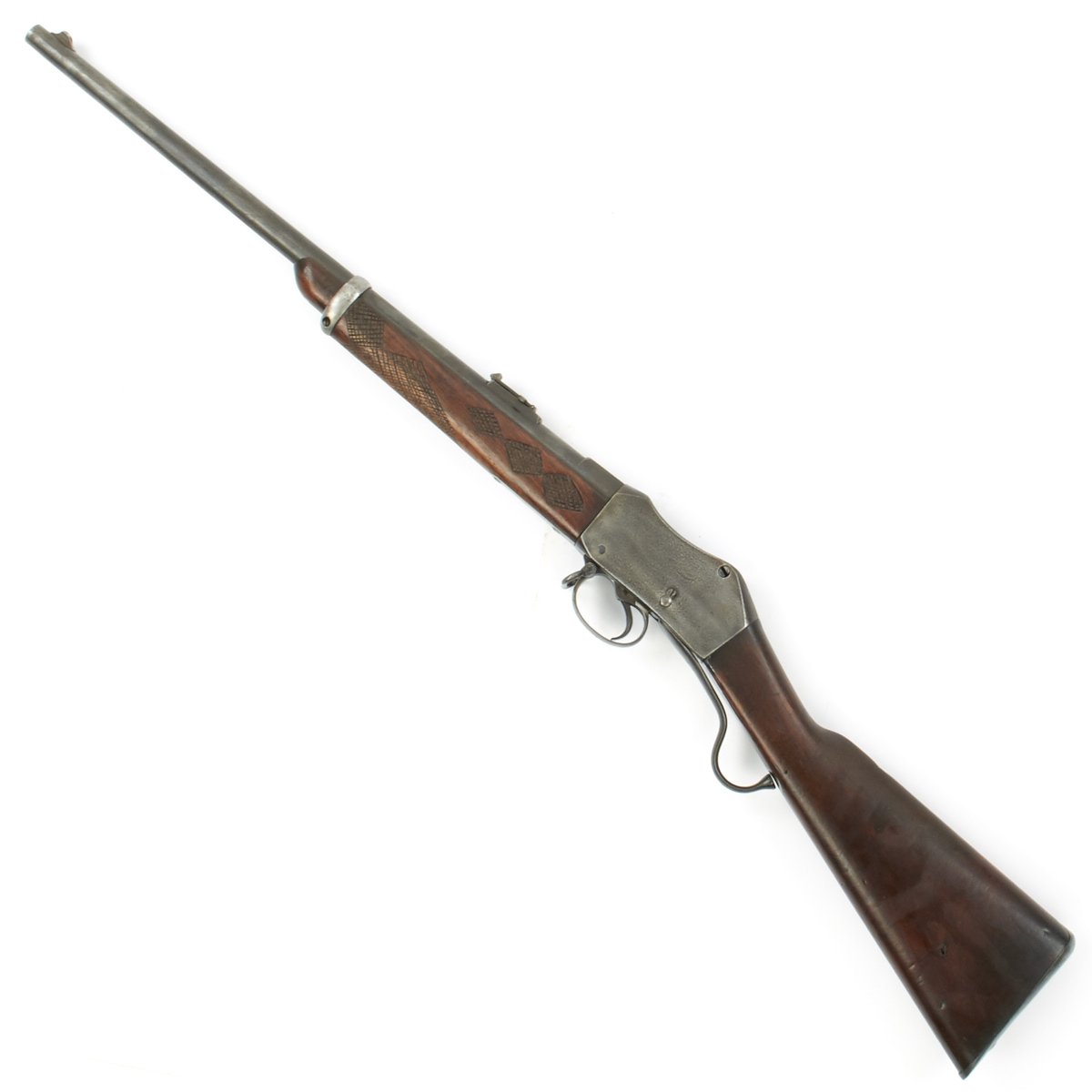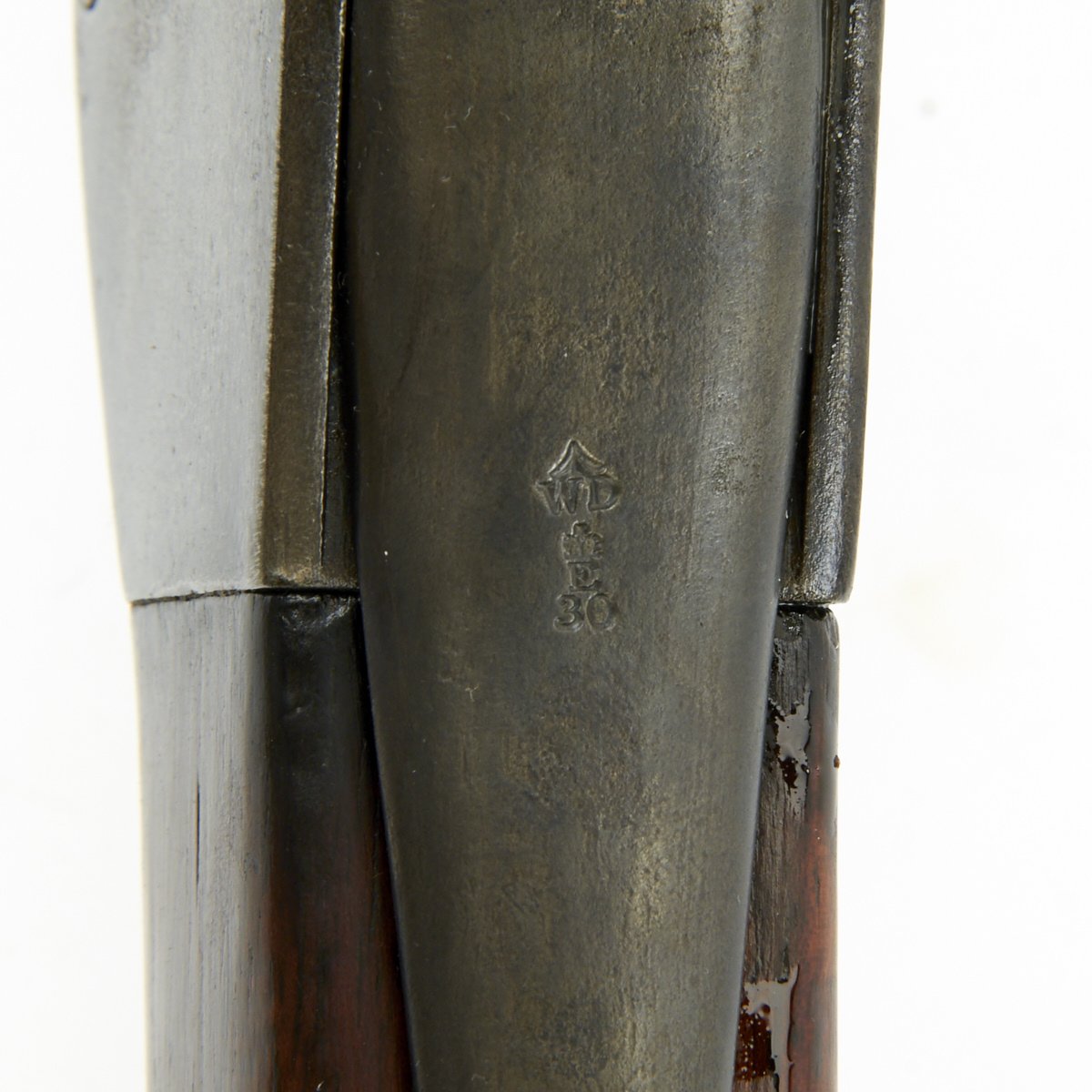Original British Martini-Henry I.C.1. Cavalry Carbine dated 1879 Recovered from a Zulu Kraal Original Items
$ 995,00 $ 248,75
Original Item: One of a Kind. This originates in a South African family Collection we have purchases and we are assured that this particular carbine was purchased from a Zulu Kraal probably 120 years ago. The fore end has been half-stocked, and the cleaning rod channel filled at the barrel band. It has also been hand-checkered with crude tools, so the checkering is of poor quality. It retains its short original ladder back sight and the markings on the right side of the steel receiver are still quite legible:
(CROWN)
V.R.
ENFIELD
1879
I.C.1.
The barrel is still the correct 21 inches, and the front sight is intact. The original British proofs on the left side are still clear, and the ENFIELD stock rondel is visible as well, though faded. The bore is worn and somewhat dark, but rifling is definitely still visible.
A very interesting example of a Martini-Henry Cavalry Carbine that fell into enemy hands, and then was purchased by a South African family. Ready to display!
Specifications:-
Year of Manufacture: 1879
Caliber: .577/.450
Ammunition Type: .577/.450 Martini-Henry
Barrel Length: 21 inches
Overall Length: 37 1/2 inches
Action: Falling Block Lever Action
Feed System: Single Shot
Martini Henry Cavalry Carbines
The Pattern was sealed and introduced on the 24th Sept 1877. LOC 3215 as “As Arms Interchangeable, Carbine Breech loading Rifled, with clearing rod Martini Henry Mk1.” “Interchangeable” was to be used in the description, and the actions were marked I.C.1. Not only did it simplify production, the carbine could be made as basic arm, with uniformed manufacturing techniques, sharing common rifle and carbine component parts, but providing an arm which simply required a change of furniture to convert from Artillery to cavalry. The new stocking arrangement required a re-think as to how the fore-end was to be fixed, the new slim barrel design did not facilitate a traditional lug hole and cross pin method of fixing used on the Mk1 & MkII rifle, so as a result a new steel hook was screwed into the bottom of the fore-stock, this in turn located into a slot in the front of the receiver.
The design carried a 21.3″ lightweight barrel, and the carbines’ weight was reduced to 7lb 8oz. Developments with the new single part tumbler for the proposed MKII rifle gave the new arm a positive cocking action, the original pattern arm had a combined half cock thumb catch on the right of the action body. To eliminate the “catch points” the front of action was rounded off to allow the carbine to slide into saddle bucket, and two rigid “Wings” protected the foresight. Most obvious external change was a new smaller cocking indicator providing too less external projection. In 1876, the safety thumb-piece catch was discontinued and not adopted.
Production costs of the new carbine per arm was £2.10s 7d.
Complaints were reported of the rear sight leaf becoming entangled or damaged by the saddlery, on the 18.4.1879, the IC1 Cavalry carbines were supplied with a folding leather back sight protector held by two screws, the screw edges were sharp and it caught clothing. A List of change No 3566 3.7.1879 gave simple instructions that the screw heads were to be softened and rounded.
Between the years 1878 and 1889 the RSAF Enfield made 130,000 IC1 carbines, but with the adoption of the .303″ calibre in the regular army, production ceased, with most of the component parts being utilized in the conversion to .303 Martini Metford and Martini Enfield carbines. IC1 Carbines emanating from the Birmingham Small Arms factory have never been seen by the author, their factory returns report that they had made over 1600 pieces in the 1890s, however, it is believed that these were made under contract by the Henry Rifled Barrel company, with parts supplied from Enfield.
NOTE: International orders of antique firearms MUST be shipped using UPS WW Services (courier). USPS Priority Mail international will not accept these. International customers should always consult their country’s antique gun laws prior to ordering.
Fast Shipping with Professional Packaging
Thanks to our longstanding association with UPS FedEx DHL, and other major international carriers, we are able to provide a range of shipping options. Our warehouse staff is expertly trained and will wrap your products according to our exact and precise specifications. Prior to shipping, your goods will be thoroughly examined and securely secured. We ship to thousands clients each day across multiple countries. This shows how we're dedicated to be the largest retailer on the internet. Warehouses and distribution centres can be located throughout Europe as well as the USA.
Note: Orders with more than one item will be assigned a processing date depending on the item.
Before shipping before shipping, we'll conduct a thorough inspection of the items you have ordered. Today, the majority of orders will be delivered within 48 hours. The delivery time will be between 3-7 days.
Returns
The stock is dynamic and we cannot completely manage it because multiple stakeholders are involved, including our factory and warehouse. So the actual stock may alter at any time. It's possible that you may not receive your order once the order has been made.
Our policy is valid for a period of 30 days. If you don't receive the product within 30 days, we are not able to issue a refund or an exchange.
You can only return an item if it is unused and in the same state as the day you received it. You must have the item in its original packaging.
Related products
Uncategorized
Uncategorized
Uncategorized
Uncategorized
Uncategorized
Uncategorized
Uncategorized
Uncategorized
Uncategorized
Uncategorized
Uncategorized
Armoured Fighting Vehicles of the World: AFVs of World War One (Hardcover Book) New Made Items
Uncategorized
Uncategorized
Uncategorized
Band of Brothers ORIGINAL GERMAN WWII Le. F.H. 18 10.5cm ARTILLERY PIECE Original Items
Uncategorized
Uncategorized
Uncategorized
Uncategorized
Australian WWII Owen MK1 Machine Carbine SMG Custom Fabricated Replica with Sling Original Items
Uncategorized












































































